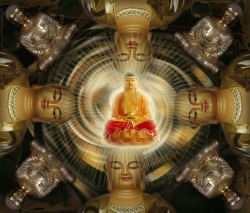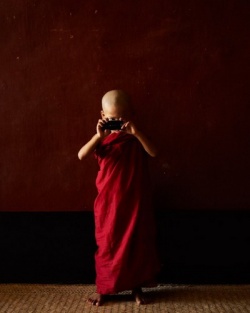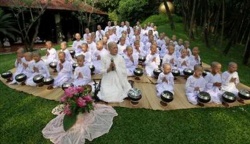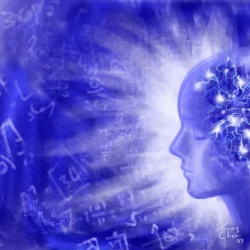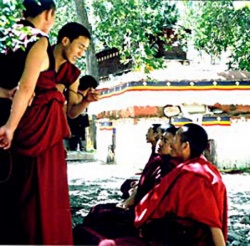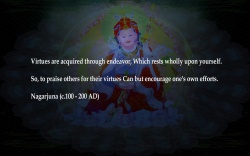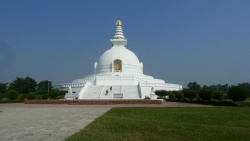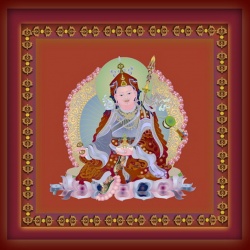How does one practice Dzogchen meditation?
Technically speaking DzogChen does not believe that there is any difference between meditation and non-meditation, in this way it is like Zen.
It does not believe that there is any difference between the two truths, i.e. mundane reality and emptiness as ultimate reality of existence.
DzogChen says that there is a deeper ground, called the basis, or primordial awareness which in which the nonduals emptiness and void are the same. Just like in Zen it is said that this state can be transmitted from practitioner to student directly.
Now of course in Tibetan Buddhism there is a lot of meditation that goes on prior to this, and tantric practices of the imagination as well.
And this type of Buddhism is considered the highest type, after you have mastered and learned all the other practices and theories.
It is the highest because in DzogChen you step beyond Buddhism, because it is an approach to things that can be practiced either by Bon adherents or Buddhists.
But there is not that much difference between these two religions, at this pont. Bon has been assimilated into Bon. The difference is not like that between Buddhism and Taoism in China.
In Dzogchen there is a key saying that Mind is like Space, which is to say that the emptiness of mind is like the Void of Space.
This is the formula that captures the idea that emptiness and void are ultimately the same.
When you realize two duals are ultimately the same that is nihilism.
But when you recognize nonduals as the alternative to the extreme artificial opposites of Buddhism and Taoism for instance which pursue different nondual goals, then instead of alienation, anomie, you get unfolding of meaning instead.
Nihilism saps meaning from the world, but Nonduals when recognize become the fount of meanings flowing into the lifeworld.
In DzogChen they speak of non-fabrication, non-elaboration, self-removal of impediments to the recognition of the primordial awareness beyond the difference between emptiness and void.
I call that Manifestation, following M. Henry in The Essence of Manifestation who is in turn following Meister Eckhart.
Meister Eckhart talks about the Godhead. We can think of this as the fourth point of a tetrahedron that has the trinity as its base. In Hinduism it is called the Nirguna Brahman. Nirguna means without characteristics.
Where the Father, Son, and Holy Ghost have characteristics, the Godhead does not.
This is more in line with the ideas of pseudo-Dionysus than with the Western Catholic church.
So the Inquisition, you know the one who the current Pope was head of before he was elected Pope, almost got Meister Eckhart, and he is still an outcast from the Catholic Church. Like so many Christian Heretics, he was so much more wise than his persecutors who were in fact evil.
To my mind he is the wisest of those who called for the recognition of nonduality in the Western tradition.
He drew quite a bit on the Sufis of his day, as did the Franciscans, but he was a Dominican.
Now if the Trinity is really a tetrahedron, i.e. the minimal solid at the next higher dimension, i.e. in three dimensions, and the godhead is the fourth point, then precisely like the argument concerning logic by Nagarjuna, what is at the center of that triangle or tetrahedron is emptiness.
In Logic it is and, or, nor, and nand that are the logical operators that form a tetrahedron, the discontinuities between which shows that emptiness is at the center of what ever is differentiated. Being is differentiated and thus is empty at its core, thus nondual in its kernel.
Same is true for the trinity with or without the Godhead.
The Godhead is not unity, not completeness, but the undifferentiated ground that the three persons of the trinity arise from.
Eckhart characterizes that manifestation as a boiling of the desert of non-characterized non-attributed Thatness of Existence.
The emptiness is in the center of the triangle, or the tetrahedron and is there because of the discontinuities between the elements of the trinity, or the quadrinity, or what ever we imagine about God in our theological fantasies.
The Godhead is like Badiou's idea of the Multiple.
It is what is there before there is a ONE arises to claim unites the three persons of the trinity.
But emptiness is not in any of these elements, but rather appears as the interstice between the elements as they are differentiated from each other.
So Being is fragmented and thus empty and thus nondual at its kernel, and the same goes for the Supreme Being and his avatar, the Christ worshiped by the Paulists.
This is an Indo-European notion, as we can see with Odin who hung on his horse the World Tree Yaddrasil for nine days and nights as a sacrifice from himself to himself in order to gain the secret of the Runes.
It just so happened that the Paulist legend concerning Christ which combined Messianic Judaism and Mithrism struck a chord in the Indo-European psyche.
So recognition of the Godhead, Nirguna Brahman, implies emptiness as Eckhart saw and discussed in his works. If you are having a mystical experience or some ideas about God that get fulfilled somehow, that is in fact illusion, because emptiness stands between us and the Godhead, and that is aconceptual and aexperiential.
So no experience or concept can reach him including trinity, oneness, goodness, and transcendental characteristics we assume that God has as the Supreme Being of our Ontotheological Metaphysics (as Heidegger calls it).
So what does this have to do with DzogChen? All this is fabrications, elaborations of primordial awareness of manifestation.
As M. Henry says following Eckhart, there is a part of manifestation, it's essence that never manifests. And that is what is called the Nirguna Brahman, or the Godhead.
It never manifests and there is an uncrossable sea of emptiness between the Persons of the Trinity and the unconscious of the trinity prior to its personhood and differentiation.
Affirming the unity and oneness of God is just a way of trying to reclaim that prior undifferentiatedness.
But this whole structure, is an elaboration or a fabrication about something we by definition cannot know anything about if God is the Absolute.
All we can know is what is the opposite of the absolute which is contingency and limitation exists for everything else besides the Absolute.
DzogChen says that such contraptions of the mind naturally are set free, and obliterate themselves. Of course, not without a struggle.
It is equivalent to saying that there is entropy and all structures of experience and concept will fall prey to entropy eventually, because that is the lowest energy state and things tend toward that optima.
It is just like the surface of a Bubble. It naturally goes to the optimal surface area which is the lowest energy state.
In a similar fashion all delusions, illusions, projections, all naturally unfold themselves and unknot themselves and evaporate.
DzogChen embodies that free and natural flow of unbinding, relaxation of distortions and un-knotting.
All this is natural to the fourth dimension for instance, and so DzogChen is like a viewpoint on things seeing them unbinding and turning inside out in the fourth dimension.
In fact, I realized the other day that turning inside out to reveal all that is hidden is the rotation of time in the fourth dimension, which can be seen as orthogonal to time as a line or circle in Metaphysics.
Of course this is what Jesus is talking about in the Gospel of Thomas which is pre-Q.
And it is what Nietzsche has Zarathustra see when he descends to the Sea, and looks at its Oblivion, and what is hidden there which will be revealed.
Hopefully bringing in these other religious motifs help clarify rather than rendering the subject more obscure.
But the whole thing is pretty obscure to begin with especially if you read Buddhist DzogChen texts, that seem to me completely impossible to understand.
I base my understanding on the first book of DzogChen by Manjushrimitra, and Mipham, and a modern Bon practitioner, Geshe Tenzin Wangyal Rinpoche.
